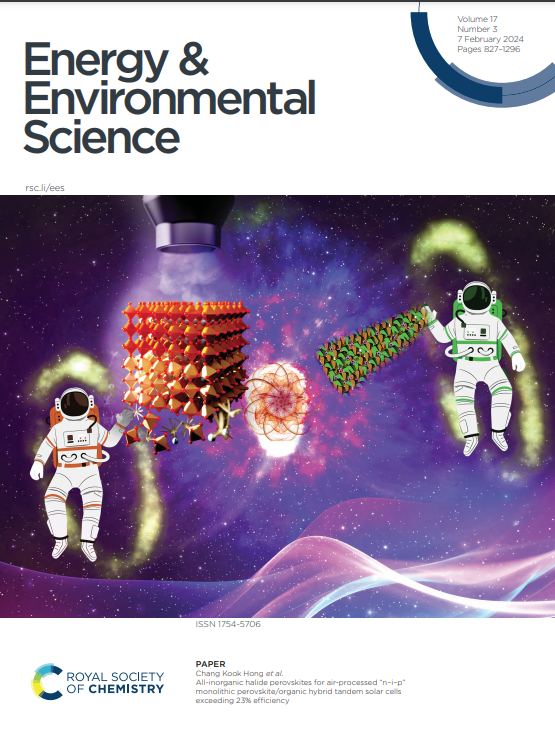High-areal-capacity Na-ion battery electrode with high energy and power densities by simultaneous electrospinning-spraying fabrication
IF 32.4
1区 材料科学
Q1 CHEMISTRY, MULTIDISCIPLINARY
引用次数: 0
Abstract
Sodium-ion batteries (SIBs) are cost-effective alternatives to lithium-ion batteries (LIBs), but their low energy density remains a challenge. Current electrode designs fail to simultaneously achieve high areal loading, high active content, and superior performance. In response, this work introduces an ideal electrode structure, featuring a continuous conductive network with active particles securely trapped in the absence of binder, fabricated using a universal technique that combines electrospinning and electrospraying (co-ESP). We found that the particle size must be larger than the network's pores for optimised performance, an aspect overlooked in previous research. The free-standing co-ESP Na2V3(PO4)3 (NVP) cathodes demonstrated state-of-the-art 296 mg cm-2 areal loading with 97.5 wt.% active content, as well as remarkable rate-performance and cycling stability. Co-ESP full cells showed uncompromised energy and power densities (231.6 Wh kg-1/7152.6 W kg-1), leading among reported SIBs with industry-relevant areal loadings. The structural merit is analysed using multi-scale X-ray computed tomography, providing valuable design insights. Finally, the superior performance is validated in the pouch cells, highlighting the electrode’s scalability and potential for commercial application.同时电纺丝-喷涂法制备高能量和功率密度的大面积容量钠离子电池电极
钠离子电池(sib)是锂离子电池(lib)的经济实惠的替代品,但其低能量密度仍然是一个挑战。目前的电极设计不能同时实现高面积负载、高活性含量和优越的性能。为此,本研究介绍了一种理想的电极结构,其特点是连续的导电网络,活性粒子在没有粘合剂的情况下被安全捕获,使用结合静电纺丝和电喷涂(co-ESP)的通用技术制造。我们发现,为了优化性能,颗粒尺寸必须大于网络的孔隙,这在以前的研究中被忽视了。独立的co-ESP Na2V3(PO4)3 (NVP)阴极具有最先进的296 mg cm-2面负载量,活性含量为97.5 wt.%,具有出色的倍率性能和循环稳定性。Co-ESP全电池具有不受影响的能量和功率密度(231.6 Wh kg-1/7152.6 W kg-1),在行业相关面积负载的sib中处于领先地位。使用多尺度x射线计算机断层扫描分析结构优点,提供有价值的设计见解。最后,在袋状电池中验证了优越的性能,突出了电极的可扩展性和商业应用潜力。
本文章由计算机程序翻译,如有差异,请以英文原文为准。
求助全文
约1分钟内获得全文
求助全文
来源期刊

Energy & Environmental Science
化学-工程:化工
CiteScore
50.50
自引率
2.20%
发文量
349
审稿时长
2.2 months
期刊介绍:
Energy & Environmental Science, a peer-reviewed scientific journal, publishes original research and review articles covering interdisciplinary topics in the (bio)chemical and (bio)physical sciences, as well as chemical engineering disciplines. Published monthly by the Royal Society of Chemistry (RSC), a not-for-profit publisher, Energy & Environmental Science is recognized as a leading journal. It boasts an impressive impact factor of 8.500 as of 2009, ranking 8th among 140 journals in the category "Chemistry, Multidisciplinary," second among 71 journals in "Energy & Fuels," second among 128 journals in "Engineering, Chemical," and first among 181 scientific journals in "Environmental Sciences."
Energy & Environmental Science publishes various types of articles, including Research Papers (original scientific work), Review Articles, Perspectives, and Minireviews (feature review-type articles of broad interest), Communications (original scientific work of an urgent nature), Opinions (personal, often speculative viewpoints or hypotheses on current topics), and Analysis Articles (in-depth examination of energy-related issues).
 求助内容:
求助内容: 应助结果提醒方式:
应助结果提醒方式:


